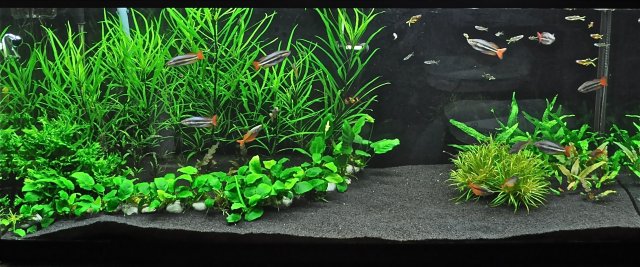Hi,
Presently I have a 22 gallon tank with plain grave(3-4mm) as substrate. I pump in CO2 using a DIY yeast method. I get about 5-6 bubbles every 5 seconds. I have amazon swords and Hygrophila corymbosa, planning to have Hairgrass and HC "cuba" as well.
As observed the substrate is not sufficient in providing the plants with enough nutrition. The swords are all yellow and brittle at the tips, suggesting a deficiency of iron (or sulphur?).
So, I've decided to change the substrate as a whole. Since the well known substrates such as ADA, aquasoil etc are not available in my region, I'm planning on creating my own as follows:
My questions are:
Will this substrate with regular dosing of the fertilizer solution keep my plants healthy(I provide sufficient lighting as well)?
Since I plan to grow HC (I will try the DSM) gravel may not be a good option for the top layer. But if I use the garden soil-red soil mixture alone, won't it cloud the water when the tank is filled up, assuming HC has carpeted most of the tank area?
Thanks!
Presently I have a 22 gallon tank with plain grave(3-4mm) as substrate. I pump in CO2 using a DIY yeast method. I get about 5-6 bubbles every 5 seconds. I have amazon swords and Hygrophila corymbosa, planning to have Hairgrass and HC "cuba" as well.
As observed the substrate is not sufficient in providing the plants with enough nutrition. The swords are all yellow and brittle at the tips, suggesting a deficiency of iron (or sulphur?).
So, I've decided to change the substrate as a whole. Since the well known substrates such as ADA, aquasoil etc are not available in my region, I'm planning on creating my own as follows:
- I've got some garden soil rich in humus and red soil. I plan to mix the two and wash the mixture by keeping it in a bucket filled with water up-to 2-3 inches above the soil surface, let it soak for 1 day and rinse it, repeating this step 4-5 times.
- Place this mixture at the bottom layer in the tank, having a height of 2 inches, and top it up with gravel of size 2-3mm for a height of 1 inch.
- I plan to dose the tank twice a week with a weak solution of Epsom salt, potassium sulfate and salt peter, about 2-3 teaspoons.
- Regular 30% water changes once a week.
My questions are:
Will this substrate with regular dosing of the fertilizer solution keep my plants healthy(I provide sufficient lighting as well)?
Since I plan to grow HC (I will try the DSM) gravel may not be a good option for the top layer. But if I use the garden soil-red soil mixture alone, won't it cloud the water when the tank is filled up, assuming HC has carpeted most of the tank area?
Thanks!



